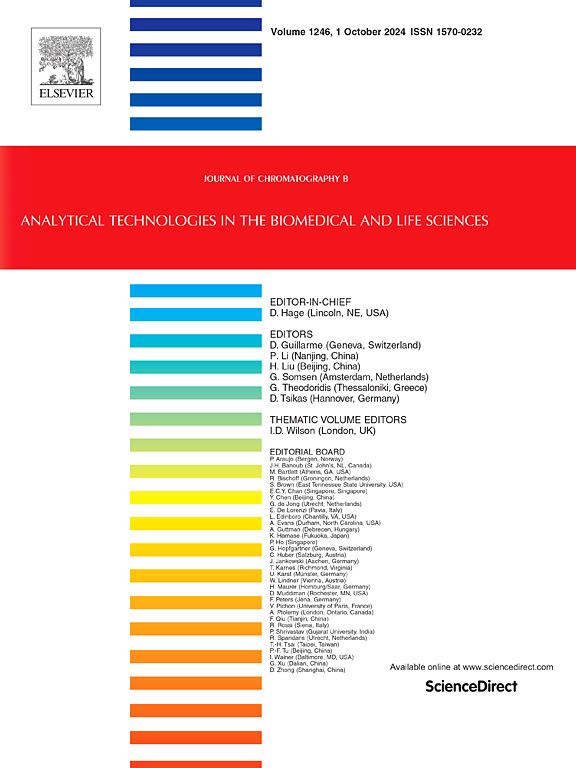利用液相色谱-质谱联用技术研究抗蛇毒血清对蛇毒成分的靶向作用
IF 2.8
3区 医学
Q2 BIOCHEMICAL RESEARCH METHODS
引用次数: 0
摘要
临床前疗效检测是评价抗蛇毒血清(AVs)质量的重要方面。近年来,体外方法的发展激增,以取代或减少对标准小鼠致死性测定的依赖。在本研究中,我们提出了一种基于反相液相色谱-质谱(RPLC-MS)的新型平台,用于在WHO推荐的溶液AV检测条件下监测毒液成分的AV活性。该方法简便,只需要5 μg的毒液和389 μg的AV即可进行分析。除了鉴定和量化AV有效靶向和非AV有效靶向的毒液成分外,MS耦合还首次研究了糖基化-翻译后修饰(PTM)对AV活性的影响。该平台能够分析完整的毒素,并促进毒液和AV培养样品之间的峰间直接比较,从而实现简单的基于ms1的相对定量,避免了使用自下而上串联质谱研究非模式生物定量的挑战。此外,它还可以定量AV中针对单个毒素的总抗体。该方法还允许我们研究时间依赖的AV活性,从而使AV作用于单个毒液成分的动力学研究成为可能。对眼镜蛇和罗素毒蛇的毒液进行了分析,证明了所提出的LC-MS方法为筛选新的或已建立的抗蛇毒血清提供了一种简单、具体、经济有效和定量的方法,为下一代抗蛇毒组学铺平了道路。本文章由计算机程序翻译,如有差异,请以英文原文为准。
Utilizing liquid chromatography-mass spectrometry to map targeting of snake venom components by antivenom
Preclinical efficacy testing is an essential aspect of evaluating quality of antivenoms (AVs). Recent years have witnessed a surge in development of in vitro methods to replace or reduce reliance on the standard mouse lethality assay. In this study, we propose a novel, reversed phase liquid chromatography-mass spectrometry (RPLC-MS)-based platform for monitoring AV activity on venom components under the WHO recommended in solution AV testing conditions. The method is simple and requires only 5 μg of venom and 389 μg AV for analysis. In addition to the identification and quantification of venom components that are effectively targeted by AV and those that are not, the MS coupling also enables, for the first time, the investigation of the impact of glycosylation – a post-translational modification (PTM) on AV activity. The ability of the platform to analyse intact toxins and facilitating direct comparison of peaks between the venom and the AV incubated samples allows for a simple MS1-based relative quantitation, circumventing the challenges associated with quantitation using bottom-up tandem MS studies for non-model organisms. Further, it also allows for quantitation of total antibodies in AV against individual toxins. The method also allows us to investigate time dependent AV activity, thus enabling studies of the kinetics of AV action on individual venom components. Venoms of Cobra and Russell's viper have been analyzed to demonstrate that the proposed LC-MS method offers a simple, specific, cost-effective, and quantitative approach for screening new or established antivenoms, paving the way for the next generation antivenomics.
求助全文
通过发布文献求助,成功后即可免费获取论文全文。
去求助
来源期刊

Journal of Chromatography B
医学-分析化学
CiteScore
5.60
自引率
3.30%
发文量
306
审稿时长
44 days
期刊介绍:
The Journal of Chromatography B publishes papers on developments in separation science relevant to biology and biomedical research including both fundamental advances and applications. Analytical techniques which may be considered include the various facets of chromatography, electrophoresis and related methods, affinity and immunoaffinity-based methodologies, hyphenated and other multi-dimensional techniques, and microanalytical approaches. The journal also considers articles reporting developments in sample preparation, detection techniques including mass spectrometry, and data handling and analysis.
Developments related to preparative separations for the isolation and purification of components of biological systems may be published, including chromatographic and electrophoretic methods, affinity separations, field flow fractionation and other preparative approaches.
Applications to the analysis of biological systems and samples will be considered when the analytical science contains a significant element of novelty, e.g. a new approach to the separation of a compound, novel combination of analytical techniques, or significantly improved analytical performance.
 求助内容:
求助内容: 应助结果提醒方式:
应助结果提醒方式:


